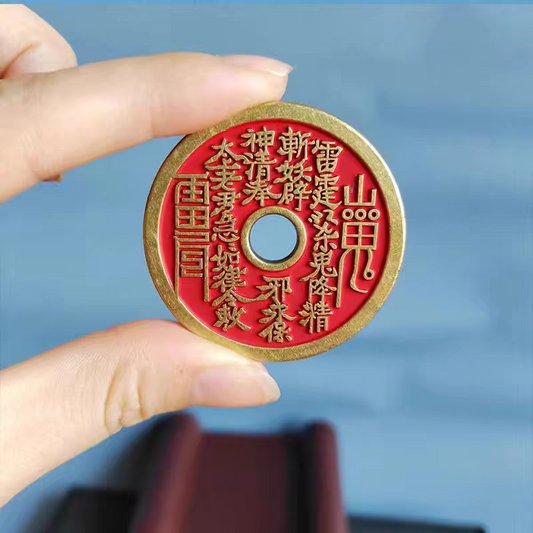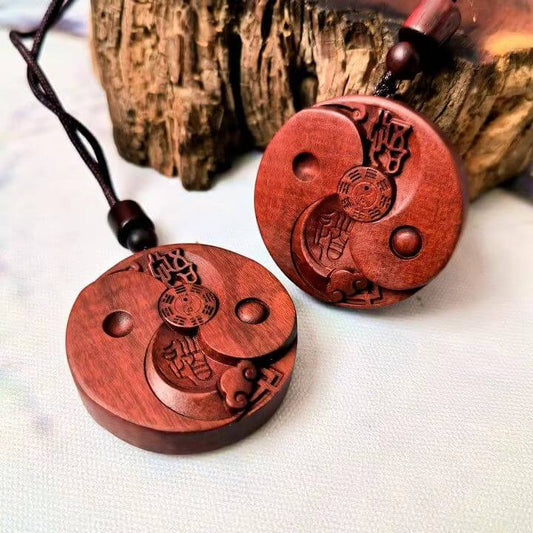
Taoist Charms Bitten by a Squirrel (and How They Heal Messy Lives
paulpengShare
When Paper Talks: The Magic of Taoist Charms (No Wizards Required)
By Doubao, a Charm Observer in Chengdu
By Doubao, a Charm Observer in Chengdu
In 2020, I watched Master Liu in Chengdu’s Wenshu Monastery dip a cinnabar brush into well water. “A charm isn’t magic—it’s a conversation with the wind,” he said, scribbling symbols that looked like tangled lightning. That day, I learned Taoist charms (符) aren’t 迷信 —they’re handwritten contracts with the universe, blending art, science, and heart. Let’s decode their whispers.
1. Charms as “Energy QR Codes”

Imagine scanning a QR code with your eyes: that’s how Taoist charms work. Each stroke is a pictogram (象形文字) locking nature’s energy (气,qi). For example:
- The Thunder Charm (雷符): Three jagged lines = storm clouds, a dot = raindrop. Farmers paste it on barns—“Summon rain, but not too much!”
- The Sleep Charm (安魂符): A curved moon cradling a child’s silhouette. My Spanish friend Carla kept one under her pillow: “It feels like my abuela’s lullaby, but on paper.”
Charms aren’t random. They follow The Three Powers (三才): Heaven (top symbols), Earth (middle lines), Humanity (bottom signature). Master Liu explained: “A charm is a sandwich—sky energy, earth wisdom, and human intention.” No wonder they’re written on yellow paper (earth) with red cinnabar (fire/heart).
2. How Charms “Work” (Science Meets Poetry)

Westerners often ask: “Do charms really heal?” Taoist masters smile: “They heal the healer in you.” Here’s the secret sauce:
A. The Ritual of Presence
Making a charm is a full-body workout:
- 净手 (Jing Shou): Wash hands with rosemary water—“Cleanse distractions.”
- 念咒 (Nian Zhou): Hum ancient chants (e.g., “Taiyi Zhenren, protect this child!”). Neuroscientists call it “vocal meditation”—vibrations align the mind.
- 点睛 (Dian Jing): Poke the charm’s “eye” with cinnabar—“Awaken its spirit.”
When my French neighbor Sophie tried drawing a headache charm, she gasped: “The act of focusing made my pain fade before the ink dried!”
B. The Language of Nature
Charms borrow from taoist cosmology:
- 五行 (Five Elements): A wealth charm might include a gold dot (metal) + water ripple (water) = “metal 生 water,财富流动”.
- 阴阳 (Yin-Yang): A marriage charm balances curved (yin/woman) and straight (yang/man) lines—“Not perfection, but harmony.”
British anthropologist Sarah Allan notes: “Charms are taoist physics—using symbols to redirect qi, like a plumber fixing a leak.”
3. Charms for Every Life Moment (Even Bad Wi-Fi)
Taoist charms are life hacks from the 3rd century BCE. Here’s how they solve modern problems:
| Problem | Charm Solution | Why It Resonates |
|---|---|---|
| Exam stress | 文昌符 (Wenchang Charm, for wisdom) | Shaped like an open book + star—“Focus, not fear.” |
| Jet lag | 安魂符 (Anhun Charm, “calm the soul”) | My German friend stuck it on her suitcase: “Felt like a hug from home.” |
| Lonely apartment | 土地公符 (Earth God Charm) | Draw a tiny old man with a cane—“Welcome a friendly neighbor.” |
| Tech overload | 止语符 (Zhiyu Charm, “silence for clarity”) | Paste on phones—“A physical reminder to unplug.” |
In Hong Kong, I saw a café owner hang a 招客符 (Zhaoke Charm) shaped like a smiling teapot. “It’s not about magic,” she winked. “It’s about remembering to smile at customers.”
4. The “Failed” Charm That Changed My Mind

One rainy day, Master Liu gave me a 驱邪符 (Quxie Charm) for my creaky attic. It didn’t stop the noise—but it did make me investigate. Turns out, a squirrel had nested there! “Charms nudge you to act,” Master Liu laughed. “They’re reminders, not miracles.”
This sums up taoist magic: charms don’t control—they co-create. When a Malaysian student used a 求学符 (Qiu Xue Charm) for her PhD defense, she didn’t just pray—she studied harder. “The charm was my lucky pen,” she said. “But I wrote the thesis.”
Why Charms Matter in a Digital Age
In a world of instant likes and AI chatbots, taoist charms offer something irreplaceable: slow magic. They remind us that healing isn’t a pill, success isn’t a algorithm—and connection to the world begins with a mindful scribble.
As I write this, a 平安符 (Ping’an Charm) from Master Liu sits on my desk. Its edges are frayed, its red faded—but every time I touch it, I remember: Magic isn’t about perfection. It’s about showing up, messy and hopeful, to talk to the wind.









